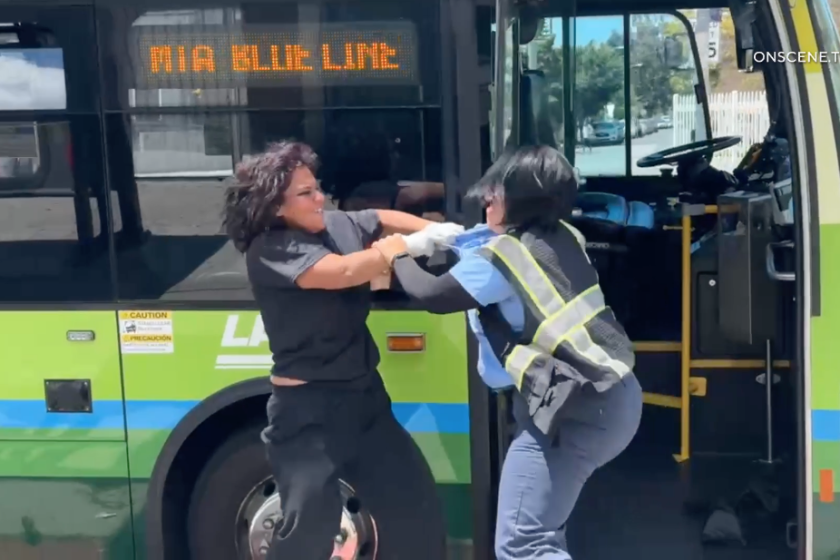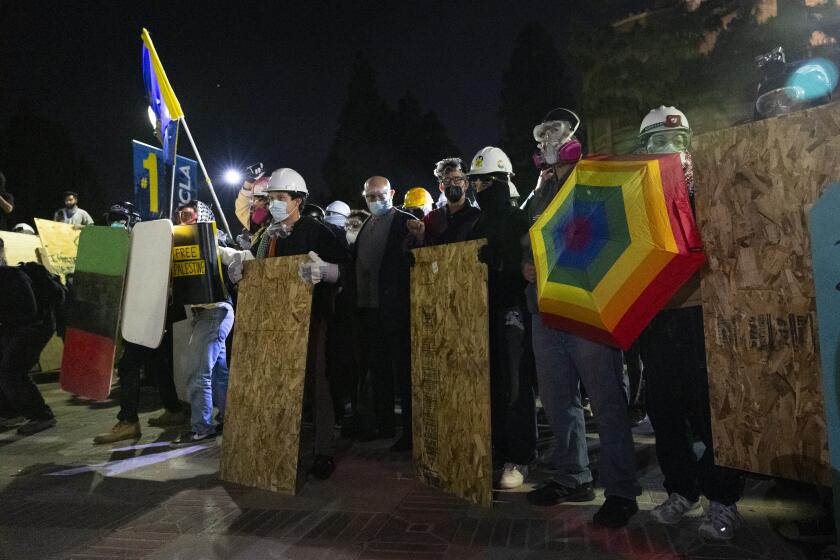CALIFORNIA COMMENTARY : Feeling Discouraged in ‘Heaven Country’ : Cambodian survivors of horrors in their homeland find that in America the rules are hard to follow.
As Samrang Suon steps past the gate of a Buddhist temple in East San Diego, the diminutive Cambodian refugee passes an invisible boundary of danger. She is no longer aware of the menacing men standing in a knot across the street, or the gang graffiti on nearby walls, or the Mexican ranchero music wailing down the block. A screen door leads her through a dark entryway to a large, cool, prayer room smelling of incense. Woven floor mats stream with light from glass doors reflecting a jungle-like garden. A larger-than-life Buddha image sits on an altar strewn with plastic flowers.
More than 75,000 Cambodians live in Southern California, congregating in Khmer communities in Los Angeles, Long Beach and San Diego. For many of them, the temple is a refuge of peace from gang wars, incomprehensible rules, bus routes and nightmares of Pol Pot.
On this peaceful afternoon, there is news that America has changed its Cambodia policy; the United States is withdrawing recognition from a resistance coalition that includes the Khmer Rouge and opening dialogue with Vietnam on Cambodia’s future. For a moment, Samrang, 31, is whiplashed back in time.
On April 17, 1975, when the U.S.-backed Lol Nol regime fled Phnom Penh and the Khmer Rouge took over, all normal life halted in Cambodia. Black-clad guerrillas ordered everyone in Phnom Penh to leave their homes for a few days so they could “clean up” the capital. Samrang, then 15, believed peace finally had come to Cambodia. She packed a change of clothes in her school bag and set off, with 11 other people in her family, into the river of humanity clogging the streets. They pushed their car piled like an oxcart with bags of rice until the Khmer Rouge barred the road. They watched helplessly while the guerrillas cut off the tires to make rubber-soled sandals. Mobbed by a “sea of black hair,” Samrang was force-marched barefoot into the jungle.
Reaksmey Mom, also 15 at the time, was staying with her aunt in another part of Phnom Penh when the Khmer Rouge came. She tried frantically to join her parents and siblings, but a guard turned her away. The first night, there was no wood to make a fire, so the grandparents burned paper money to boil rice. A body was floating in the temple pond where they drank.
The urban populace was driven back to the Year Zero. Pol Pot was wiping the slate clean and beginning history again. He had monumental visions of rebuilding the country--dams, dikes, farms, roads--entirely by hand, by the labor of the despised “elite,” the city people, artists, teachers, monks, doctors, children and elderly. The Communist system, personified by the terrifying Angka guards, ruled absolutely, and infractions were punished by torture and execution. Samrang’s father grew too ill to work, and she watched her parents starve to death. Her 11-year-old brother stole a fish net to try to feed them; he was caught, and the Angka kicked him until he could not get up and his body “swelled in death.”
Reaksmey’s grandparents also died of starvation. She watched in horror as her cousin was raped by five Angka, who then sawed her skin with serrated palm leaves and left her to die. When her baby nephew cried for his mother, he was bayoneted.
Between 1 million and 2 million people were consumed by the genocide in Cambodia’s countryside.
The Vietnamese invaded in 1979, driving Pol Pot from power. Fearful of their “rescuers,” too, the survivors of “the killing fields” fled to Thailand. From there, thousands were fast-forwarded to post-modern America. Among them were Samrang and Reaksmey.
“This is heaven country,” Reaksmey thought when she arrived in America. “But next day I feel discouraged. A strange new world, I don’t know what’s gonna happen.” Reaksmey was given $3 pocket money and sent to live in a largely black housing project in Texas. The only black people she had seen before were Cuban Communists in Cambodia. An air conditioner had been removed from the bedroom, leaving a gaping hole in the wall, and Reaksmey spent her first night in America crouching with a knife to protect herself from imagined intruders.
Some Cambodians, like Samrang and Reaksmey, adapted well to the American dream of independence. Both have worked as translators in a counseling center at the Union of Pan Asian Communities in San Diego. But a 1988 study by two San Diego State sociologists, Ruben Rumbaut and Kenji Ima, reveals that Cambodians generally have fared worse than other Asian immigrants. Cambodians have a higher percentage of single-parent families headed by women, frequently widows of the genocide. And they have a higher rate of depression.
Families that held together to survive the killing fields have broken apart in the social freedom of America. In the mental-health clinic, Reaksmey saw the family breakdown close-up. “Parents can’t control children,” she says. “Fathers don’t have job. They feel shame. They lost their pride. Wife does not respect them. Many family end up fighting with each other. Children come under peer pressure, cut school, take drugs, join gang. This country is too much freedom for children.”
Psychologically, it is hardest for people who lost their children in Cambodia. They have no future.
“We are alive in our bodies,” says a widow. “But our hearts and minds are dead to us.”
Not far from the temple, four families share a four-bedroom rental house. The living room is swept clean and all furniture except a couch has been removed. A large color television is raised on a kind of altar, beneath pictures of Pope John Paul II and Buddha. The TV is on, and a young Khmer girl is dancing on the screen, her hands molded in gestures that were captured in stone a thousand years ago in the relief carvings of Angkor Wat.
At midday on a working day, the men bend idly over a board game. They are able-bodied, and at first glance they appear to be perfect material for a Ronald Reagan anecdote on the evils of welfare. Only in conversation can one see the crippling fear in their eyes.
“Life is really hard here,” says a client back at the mental-health center. “No river to drink water. No light if you don’t pay. In Cambodia, at least you can pick fruit from the jungle and grow rice. In America everything you do costs money, and you have to drive a car everywhere and the rules are hard to follow.”
“It’s America’s fault, pardon my words,” says Samrang. “In this country, you make it too easy not to work. These men want to work, but if they do, they lose their health insurance. They get sick and lose their job. Why work when they can lose everything?”
Many men in the group home dream of returning to their country and wonder if Bush’s policy will bring peace. They ask: What are conditions like in Phnom Penh? Is it safe? Are the Khmer Rouge still attacking the city? Who will win, Pol Pot or Premier Hun Sen?
They are divided politically, with some supporting the Hun Sen regime, others Prince Sihanouk, and one asking for an international custodianship to rebuild the country. But they all assent to one message: “No Pol Pot army. No Pol Pot party. Tell George Bush to have a peaceful Cambodia with elections.” Their faith that, somehow, America could make everything right in Phnom Penh contradicts the fact that, until recently, America supported Khmer Rouge representation in the United Nations.
Blocking out painful realities is a survival tool. For some, numbness has become crippling. In a therapy group, three men and two women suffering depression try to confront their own pasts. It is difficult for them to open up. Speaking in Cambodian, their voices need no translation. Their upper lips quiver, eyes go out of focus, voices tremble as they recount their stories. Among five survivors, 26 deaths are recounted in one hour.
“Angka kill my husband and starve my children,” says one woman. Angka is never personalized. It is the abstract term for the perpetrators of genocide. “Some Angka live in Long Beach,” she claims, hidden in the Cambodian community of 45,000 there.
Chillingly, Cambodia’s Hitler also lives: Somewhere along the Thai border, Pol Pot hides out with his army, still the strongest rebel force in the country.
The civil war is not over in Cambodia--or in America. Age-old rivalries among Vietnam, Cambodia, Laos and Thailand are mirrored in violence between refugee youth gangs here. In San Diego, the friction caused the Cambodian New Year’s celebration to be cancelled. This spring, two Cambodian youths were shot to death near a San Diego freeway by a suspected rival Asian gang. The father of one victim moved away, overwhelmed by the irony of losing a child to violence in America.
The shadow of death follows Cambodians wherever they go. Last year, it came alive to Reaksmey in a letter from her only surviving sister. She learned that in 1975 her father, a former government official, was hacked into three pieces, her mother and little sister dragged from a hospital and killed, her brother disemboweled. “I used to live to see my parents’ face,” she says, “now I live for my two daughters.”
Outwardly in control, Reaksmey murmurs: “I feel like a drop of water in a lotus leaf. It can roll out any time.”
Within the walls of the Buddhist sanctuary, sipping Coca-Cola beside a saffron-robed monk, the Cambodians seem to be at peace. But beyond the gates lie unimaginable fears. “Angka” lives.
Cambodia doesn’t need just a political settlement. It needs psychological healing.
More to Read
Start your day right
Sign up for Essential California for news, features and recommendations from the L.A. Times and beyond in your inbox six days a week.
You may occasionally receive promotional content from the Los Angeles Times.






